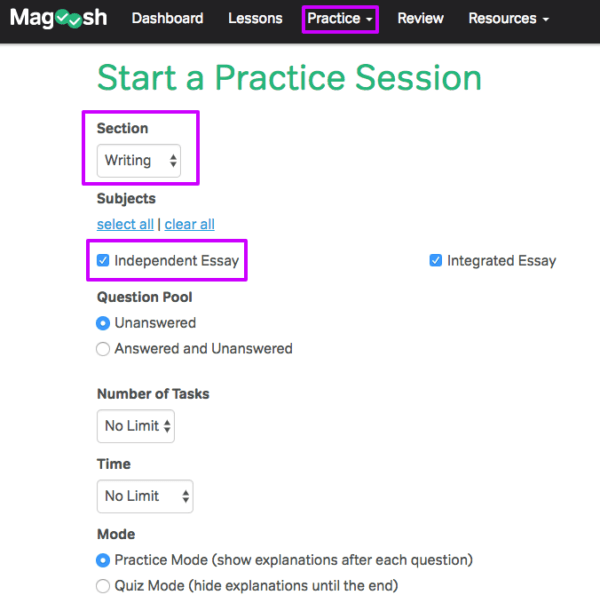
While the TOEFL is generally a very different type of test from the GRE, the GMAT, and the SAT, there are a few similarities, and the nature of the TOEFL Writing topics (specifically TOEFL Independent Writing topics) is one of them. As with most standardized tests, the TOEFL asks you to write an essay.
Well, it asks for two essays. For a quick summary of the two Writing tasks (Independent Writing and Integrated Writing) and how they fit into the Writing section as a whole, see Kate’s breakdown of the TOEFL Writing section. And for TOEFL Integrated Writing topics, jump down to this part of the post.
Table of Contents
TOEFL Writing Topics: Task 2 Subject Matter
Let’s look at the TOEFL Writing topics that you might see for that second TOEFL essay, the “independent task.” (Also note that the TOEFL Independent Writing task is particularly similar to the GRE issue AWA task, something to bear in mind if you are prepping for the TOEFL and GRE at the same time.)
On the one hand, there are a LOT of different TOEFL Writing topics. You might be asked to write an essay about any of the following:
technology, education, media, family, small towns vs. big cities, the benefits of constructing something such as a large factory or new movie theater, the qualities of a good neighbor, life for university students, the way people should work, social media, the impact of human activity on the environment, education (the education of young children, high school students, young adults, etc.), different kinds of people you’d want to work with, important characteristics of a co-worker, cell phones, the traits of the best teachers, the attitudes of young people, traveling to new places, use of free time, etc., etc…
You get the idea. There are many different topics for the test-taker to think about and give a personal opinion on.
The Basic Structure of an Integrated Writing Prompt
But on the other hand, there are only a few different types of Independent Writing tasks. And even with those different types, the tasks are very similar: give your main points, use reasons to support them, include specific points and specific examples in your reasoning, etc…. Since these tasks involve expressing your point of view, sharing your personal experiences is also a common practice across the different types of the Independent TOEFL Writing task. Essentially, you express your opinion in a thesis statement, add related main ideas to each paragraph, and support your thesis and main ideas in a variety of ways.
ETS does provide a list of TOEFL independent essay questions in the 4th edition of the TOEFL Official Guide, and it’s a good idea to look over those sample questions. But there’s an excess of information there—we want to know some more useful generalities! So let’s divide those subjects into types. (Click here to jump ahead to the first of those three types!)
A Note on Practicing TOEFL Writing Topics
If you practice writing the essay before test day (a good idea!), then you can use an essay prompt from the ETS list mentioned above. This is a great option.
For more customized practice, sign up for Magoosh’s 7-day free trial, select “Practice –> Custom Practice –> Writing Section”, and then try one of our premium TOEFL Writing prompts. You can also choose to only practice the independent task if that’s what you want to focus on. The trial lasts 7 days and you don’t need a credit card to sign up.
Let’s talk about the TOEFL “independent task” Writing topic types I mentioned above!
TOEFL Writing Topic Type 1: Choose a Side
This is by far the most common Independent Writing question type. These TOEFL prompts ask you to choose A or B then explain your decision. There is no “wrong” decision here. You can side with the first or second point, as long as your argument is well-supported and you give an effective response. There are a couple of different approaches to writing this type of essay, but the simplest form is the “five-paragraph essay.” Usually, this is only four paragraphs, because you don’t have that much time—the test only gives you 30 minutes to complete your Independent essay.
So if you choose A, you might write an essay that looks like this:
- Introductory paragraph
- A is better
- Body 1
- Reason 1 and examples of why A is better
- Short contrast with B
- Body 2
- Reason 2 and examples of why A is better
- Short contrast with B
- Concluding paragraph
- Why this is significant in the real world
Of course, there are other ways to write an essay, but it’s a good idea to use a relatively simple structure for clarity; this tends to be the best, easiest path to a high score. This is more true for the TOEFL than it is for essays on other tests, like the GRE, because the TOEFL is really a test of communication and how well you can write in the English language.
Here are some examples of the “choose a side” Writing topics:
“Some would say it is more important to have an enjoyable job than to have a job with a high salary. Do you feel this is true or not true? Explain your thoughts using examples.”
“Opinion: It is better to have a low-stress job than a job with lots of responsibility. Do you hold this opinion, or disagree with it? In your essay, include supporting details.”
“Apartment buildings are the preferred living space for many people. But many individuals prefer living in a house. Which do you prefer? Explain your thoughts using examples.”
“It could be argued that technology makes our lives easier and simpler. But there are certainly people who feel life has become more complicated due to modern inventions. Which opinion do you agree with? In your essay, include supporting details.”
“This week, your government announced plans to invest significant amounts of money in the exploration of outer space. Write an essay explaining why you are either for this new plan or against it. Explain your thoughts using examples.”
Do you agree or disagree with the following statement?
Modern life is easier than life in the past.
Use specific details and examples to support your answer.
Would you rather live in a large city or the countryside? Explain your choice, giving specific reasons and examples.
You might also get a slightly more complicated version of the “choose a side” prompt that asks you to compare sides, like these:
“Many workers change jobs a few times in their career. However, a number of workers instead do the same type of work throughout their career. Of these two career paths, which is a better option? In your essay, include supporting details.”
Which of these two is preferable for you: a high-paying job that you didn’t enjoy, or a lower-paying job that you did enjoy? Explain your reasoning, using specific reasons and examples.
Some students prefer to study many different subjects at once, while others prefer to focus on one topic at a time. Would you rather take a semester of classes in different subjects or a semester of classes in the same subject? Explain your choice, using specific reasons and examples.
In that case, you could still use the structure I showed above, but you would emphasize the contrasts with “B” and write a bit more about them.
Writing Topic Type 2: View Both Sides
This is very similar to the “choose a side” type of essay subject, but it’s a little bit more complicated because you have to think from two different standpoints. Thankfully, it’s also not as common.
Here are a couple of examples:
“Your family and friends are encouraging you to buy a new car. What are some benefits and downsides of purchasing a brand new vehicle? Explain your thoughts using examples.”
“What are some good things and bad things about remaining in your hometown as an adult? In your essay, include supporting details.”
There are a couple of different ways you might structure an essay like, but the simplest one may be the best.
- Intro
- General statements about issue
- Body 1
- Advantages and examples
- Body 2
- Disadvantages and examples
- Conclusion
- Why this is significant in the real world
Writing Topic Type 3: Describe or Explain
In a way, this is the most difficult type of Independent essay question because it doesn’t give you an A or B situation. Instead, you have to think of your own subject from a very big pool of possibilities.
“If you could choose any place to live in the world, where would you live? Explain your thoughts using examples.”
“How was your grandparents’ life different than yours? In your essay, include supporting details.”
“What is your favorite movie and why? In your essay, include supporting details.”
“What is your favorite place to visit near your home? Explain your thoughts using examples.”
Because these Writing topics don’t give you a yes-no or A-B choice, it’s easy to get stuck in the planning phase. (By the way, planning is incredibly important for writing any standardized test essay; don’t skip it!)
The structure doesn’t have to be very different, though. Here’s a rough idea of how you might organize a descriptive essay:
- Intro
- Your choice/subject
- Body 1
- Reason 1 and examples
- Body 2
- Reason 2 and examples
- Body 3
- Reason 3 and examples
- Conclusion
- Why this is significant in the real world
Notice I added one more body paragraph. Because there’s no “other side” to deal with, you have more time to explain the one topic you chose. So why not use that time for another paragraph!
This Is Only Half of TOEFL Writing (the Other Half is the Integrated Task)
Remember that the Independent essay is only half of the TOEFL Writing section. There’s also the integrated task. Although the TOEFL Integrated Writing Task is not the main focus of this post, let’s go through some basics of the first half of the TOEFL Writing section.
First off, know that TOEFL Writing Task 1 has a reading passage and a listening passage. The listening passage features part of a lecture. The speaker in the lecture will disagree with or challenge the claims in the reading. As you navigate the reading and listening for this first task, you don’t need to pay much attention to the written portion. The focus of your essay will be summarizing what the speaker said, so the reading is merely background information.
The context of the reading and speaking in TOEFL Integrated Writing tends to be based on the United States. So, for example, if you see a passage related to business or economics, any amount of money described would probably be in American dollars, and examples would involve American consumers or American companies. Still, other non-American contexts may come up. You could encounter a topic about an important influence on a European art movement, or deal with a science topic; science topics in this task are typically international or culturally neutral.
Want more help with TOEFL Integrated Writing? Magoosh has you covered! See our complete guide to the TOEFL Integrated Writing task, which includes a free TOEFL Integrated Writing practice task from Magoosh. And you can find a second free Magoosh TOEFL Integrated Writing practice task in our complete guide to TOEFL Writing samples.
Ready For Some Practice?
If you’re ready to try out writing the Independent task for yourself, try a customized practice session in Magoosh TOEFL’s free trial or take a look at our full-length TOEFL Writing mock test, which will also introduce you to the integrated task:
Sample essays are another great resource for practice. You can review sample TOEFL essays for both Independent Writing and Integrated Writing in the aforementioned Magoosh’s complete guide to TOEFL Writing samples and in our TOEFL Writing Templates. And partial or complete sample essays can also be found in the following posts:
Task 2 Sample Essays
- TOEFL Independent Writing: Unsupported Claims
- TOEFL Independent Writing: Correcting Disorganized Answers
- Examples of Counter-Arguments
- TOEFL Writing Task 2 Model Answer
- Prewriting for TOEFL Writing Task 2
- How to Use Transitions in Your Writing
Task 1 Sample Essays
- How to Revise TOEFL Writing
- Paraphrasing in TOEFL Integrated Writing
- The Complete Guide to TOEFL Integrated Writing
- Paraphrasing in TOEFL Integrated Writing
Last but certainly not least, I’ve written a quick summary of the best ways to practice TOEFL Writing. You can use that as a guide to tie all of your TOEFL Writing topic practice together!







Leave a Reply